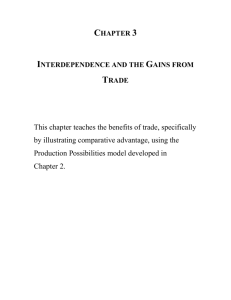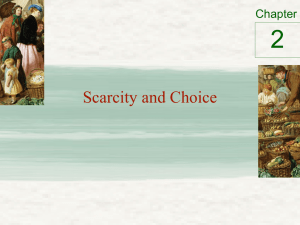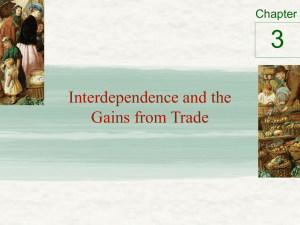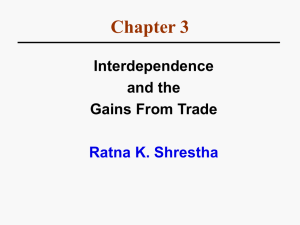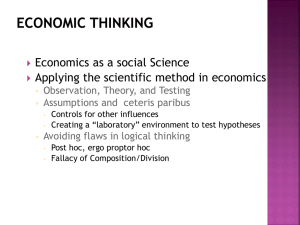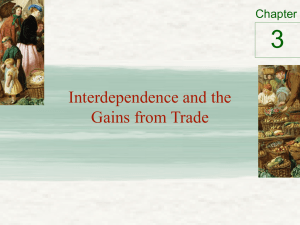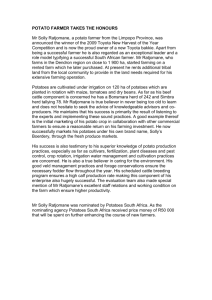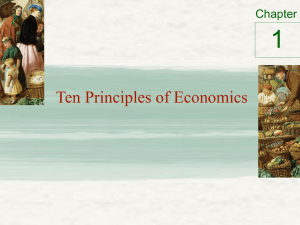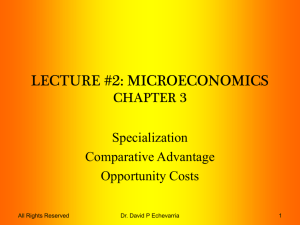Chapter 3 - Patrick M. Crowley
advertisement
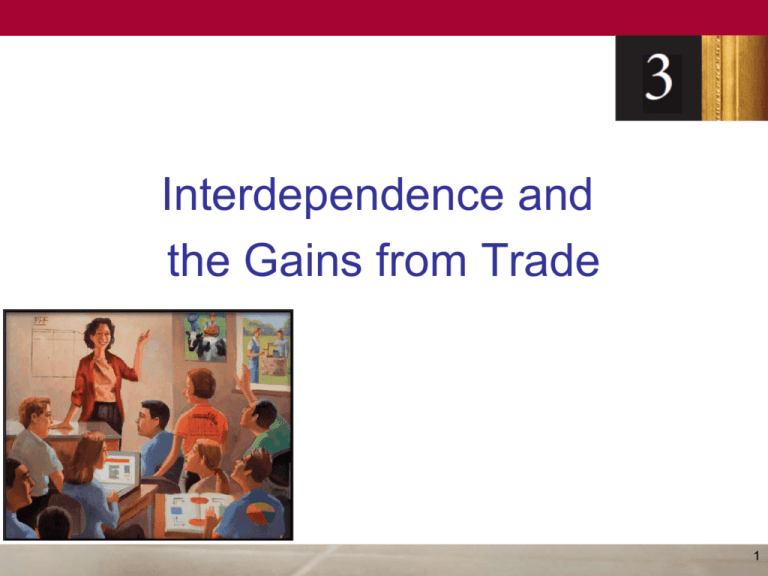
Interdependence and the Gains from Trade 1 A Parable for the Modern Economy • Only two goods – Meat – Potatoes • Only two people – Rancher – Farmer 2 A Parable for the Modern Economy • If rancher (R) produces only meat – and farmer (F) produces only potatoes – then both have potential to gain from trade • If both R and F produce both meat and potatoes – Both can potentially gain from specialization and trade • Production possibilities frontier (PPF) – Various mixes of output that economy can produce if all resources used to capacity 3 Figure 1 The Production Possibilities Frontier (a) Panel (a) shows the production opportunities available to the farmer and the rancher. 4 Figure 1 The Production Possibilities Frontier (b, c) (b) The farmer’s production possibilities frontier Meat (oz) If there is no trade, the farmer chooses this production and consumption. (c) The rancher’s production possibilities frontier Meat (oz) 24 8 12 4 0 If there is no trade, the rancher chooses this production and consumption. B A 16 32 Potatoes (oz) 0 24 48 Potatoes (oz) Panel (b) shows the combinations of meat and potatoes that the farmer can produce. Panel (c) shows the combinations of meat and potatoes that the rancher can produce. Both production possibilities frontiers are derived assuming that the farmer and rancher each work 8 hours per day. If there is no trade, each person’s production possibilities frontier is also his or her consumption possibilities frontier. 5 A Parable for the Modern Economy • Specialization and trade – Farmer – specialize in growing potatoes • More time growing potatoes • Less time raising cattle – Rancher – specialize in raising cattle • More time raising cattle • Less time growing potatoes – Trade: 5 oz of meat for 15 oz of potatoes – Both gain from specialization and trade 6 Figure 2 How Trade Expands the Set of Consumption Opportunities (a, b) (a) The farmer’s production and consumption Meat (oz) Farmer's production and consumption without trade 8 A* 5 4 0 A 16 17 (b) The rancher’s production and consumption Meat (oz) 24 Farmer's consumption with trade Rancher’s production with trade 18 B* 13 12 B Farmer's production with trade 32 Potatoes (oz) 0 12 24 27 Rancher’s production and consumption without trade Rancher’s consumption with trade 48 Potatoes (oz) The proposed trade between the farmer and the rancher offers each of them a combination of meat and potatoes that would be impossible in the absence of trade. In panel (a), the farmer gets to consume at point A* rather than point A. In panel (b), the rancher gets to consume at point B* rather than point B. Trade allows each to consume more meat and more potatoes. 7 Figure 2 How Trade Expands the Set of Consumption Opportunities (c) The proposed trade between the farmer and the rancher offers each of them a combination of meat and potatoes that would be impossible in the absence of trade. In panel (a), the farmer gets to consume at point A* rather than point A. In panel (b), the rancher gets to consume at point B* rather than point B. Trade allows each to consume more meat and more potatoes. 8 Comparative Advantage • Absolute advantage – Produce a good using fewer inputs than another producer • Opportunity cost – Whatever must be given up to obtain some item – What you give up to get something else – Measures the trade-off between the two goods that each producer faces 9 Table 1 The Opportunity Cost of Meat and Potatoes 10 Comparative Advantage • Comparative advantage – Produce a good at a lower opportunity cost than another producer – Reflects the relative opportunity cost • Principle of comparative advantage – Each good - produced by the individual that has the smaller opportunity cost of producing that good 11 Comparative Advantage • One person – Can have absolute advantage in both goods – By definition, cannot have comparative advantage in both goods • For different opportunity costs – One person - comparative advantage in one good – The other person - comparative advantage in the other good 12 Comparative Advantage • Opportunity cost of one good – Inverse of the opportunity cost of the other • Gains from specialization and trade – Based on comparative advantage – Total production in economy rises • Increase in the size of the economic pie • Everyone – better off – Can apply to individuals, firms, and countries 13 Comparative Advantage • Trade can benefit everyone in society – Allows people to specialize • The price of trade – Must lie between the two opportunity costs • Principle of comparative advantage explains: – Interdependence – reliance on other individuals, firms or countries – Gains from trade – applies to individuals, firms and countries 14 Applications of Comparative Advantage • Should Tom Brady Mow His Own Lawn? • Brady, in 2 hours – Mow his lawn, or – Film a TV commercial, earn $20,000 • Forest Gump, in 4 hours – Mow Brady’s lawn – Work at McDonald’s, earn $40 15 Applications of Comparative Advantage • Should the U.S. trade with other countries? • Imports – Goods produced abroad and sold domestically • Exports – Goods produced domestically and sold abroad 16 Applications of Comparative Advantage • Should the U.S. trade with other countries? – U.S and Japan • Each produces food and cars • One American worker, one month – One car, or – Two tons of food • One Japanese worker, one month – One car – One ton of food 17 Applications of Comparative Advantage • Principle of comparative advantage – Each good – produced by the country with the smaller opportunity cost of producing that good • Specialization and trade – All countries have more food and more cars 18 Free trade and comparative advantage • In theory – Clear that there are gains from specialization and trade • In practice – What types of issues do you think arise in applying the theory in practice? 19

